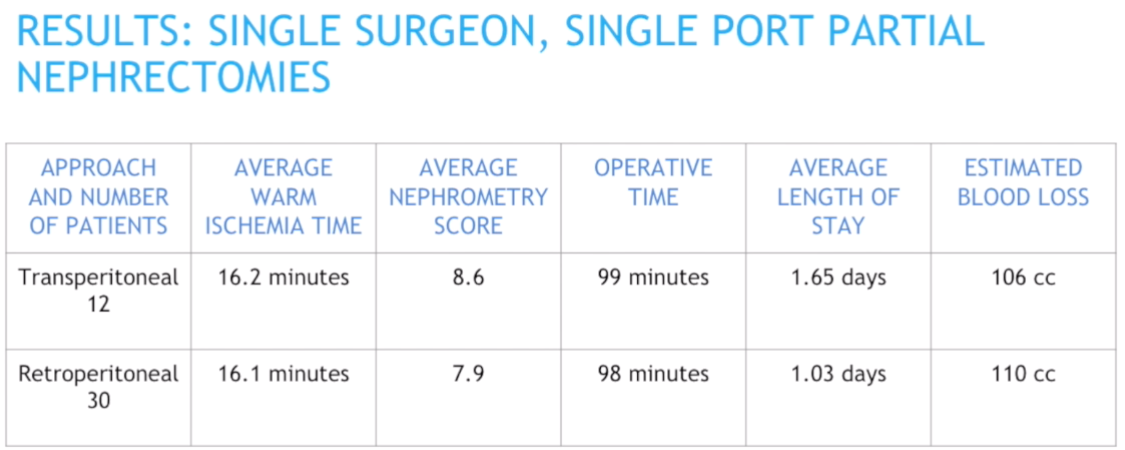Back
Poster, Podium & Video Sessions
Video
V10: Adrenal & Renal Oncology I
V10-11: Partial Nephrectomy in Complex Kidney Masses - Two Approaches with the DaVinci Single Port Robot
Sunday, May 15, 2022
5:10 PM – 5:20 PM
Location: Video Abstracts Theater
John Sheng*, Chrystal Chang, Newark, NJ, Michael Stifelman, Mutahar Ahmed, Hackensack, NJ
- JS
John Y. Sheng, MD
Rutgers New Jersey Medical School
Video Presenter(s)
Introduction: - Performing partial nephrectomy on patients with complex hilar anatomy and/or posterior tumors can be challenging, sometimes requiring placement of an additional assistant port and/or mobilizing the entire kidney.
- We demonstrate how the DaVinci Single Port Robot facilitates certain surgical approaches in performing partial nephrectomy on complex masses.
- We show how the procedure can be performed with one incision with both a transperitoneal approach on a patient with complex hilar anatomy and an entirely retroperitoneal approach on another patient with a posterior mass.
Methods: Case - Transperitoneal Approach
- 41 year old male who was found to have an enhancing left 3cm hilar mass on workup for microhematuria.
- He also has a duplicated collecting system on the same side as his mass.
Case - Retroperitoneal Approach
- 61 year old female who was found to have an enhancing 2cm left posterior kidney mass on workup for microhematuria.
Results: - For both approaches no additional assistant port was needed
- A single 15mm incision was made on the left side of the abdomen for the robotic instruments. No assistant port was used, making both true single port procedures.
- For the retroperitoneal approach, we did not have to mobilize the entire kidney and then flip it medially which would have been needed with a multiport robotic approach.
- We had quick access to the hilum and vasculature as well as the mass itself.
- The patient had only one incision for both approaches, resulting in better cosmesis and possibly less post operative pain.
Conclusions: - True single port partial nephrectomy can be performed via both a transperitoneal or retroperitoneal approach. This can be customized based on surgeon preference, comfort level and patient anatomy
- Its utilization can allow for the most minimally invasive approach, despite complex kidney anatomy.
- However there is a learning curve in the use of the Da Vinci SP robot.
- We hope to improve our techniques and surgical approaches further to keep our procedures as minimally invasive as possible.
Source of Funding: None

- We demonstrate how the DaVinci Single Port Robot facilitates certain surgical approaches in performing partial nephrectomy on complex masses.
- We show how the procedure can be performed with one incision with both a transperitoneal approach on a patient with complex hilar anatomy and an entirely retroperitoneal approach on another patient with a posterior mass.
Methods: Case - Transperitoneal Approach
- 41 year old male who was found to have an enhancing left 3cm hilar mass on workup for microhematuria.
- He also has a duplicated collecting system on the same side as his mass.
Case - Retroperitoneal Approach
- 61 year old female who was found to have an enhancing 2cm left posterior kidney mass on workup for microhematuria.
Results: - For both approaches no additional assistant port was needed
- A single 15mm incision was made on the left side of the abdomen for the robotic instruments. No assistant port was used, making both true single port procedures.
- For the retroperitoneal approach, we did not have to mobilize the entire kidney and then flip it medially which would have been needed with a multiport robotic approach.
- We had quick access to the hilum and vasculature as well as the mass itself.
- The patient had only one incision for both approaches, resulting in better cosmesis and possibly less post operative pain.
Conclusions: - True single port partial nephrectomy can be performed via both a transperitoneal or retroperitoneal approach. This can be customized based on surgeon preference, comfort level and patient anatomy
- Its utilization can allow for the most minimally invasive approach, despite complex kidney anatomy.
- However there is a learning curve in the use of the Da Vinci SP robot.
- We hope to improve our techniques and surgical approaches further to keep our procedures as minimally invasive as possible.
Source of Funding: None


.jpg)
.jpg)